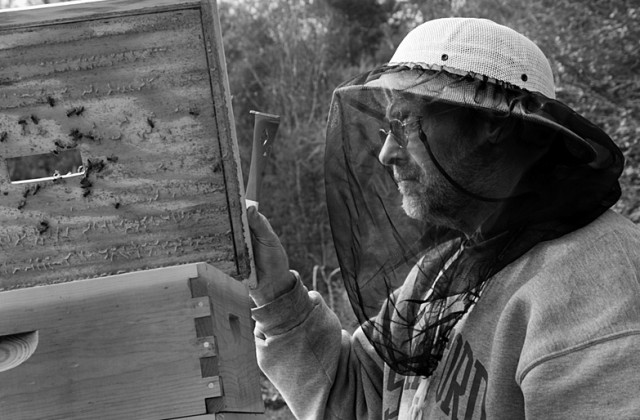It’s a Tough Life For Beekeepers
By Lindsey Pizzica Rotolo
Honeybees are not native to North America, but records show that colonies of the adept honey makers were shipped to Connecticut from England as early as 1644. Beekeeping in our neck of the woods is as old a tradition as we have, and one testament to our Yankee resolve, as beekeeping is not a pursuit for the faint of heart.
If braving a swarm of stinging insects won’t stop you from your quest for facilitated pollination of your flora and the amassing of honey, then there are several other perils that could. First of all, an abundance of natural predators at your door… There’s the black bear of course, raccoons, skunks, sandhill cranes, flycatchers and bald-faced hornets, too.
Another hurdle for beekeepers is ensuring that the hive makes it through our long winters. While honeybees possess a powerful instinct to cluster around the queen once the temperature dips into the 40s, they must have enough stored honey to produce the body heat necessary to raise the temperature of the hive to its optimum 85-95 degrees. When you first obtain a hive, it takes the bees a long time to build their home and they won’t focus on honey production until that task is done. As the result, there’s a good chance their honey stores may not be adequate enough for the first winter.
A newer threat to the hive, Colony Collapse Disorder (CCD), started affecting significant portions of hives six years ago. While scientists haven’t been able to determine the exact cause, it is widely believed that CCD is the result of the combination of more frequent severe weather events and the increased use of pesticides and other environmental toxins.
Norfolk resident Hartley Mead bought his first hive last spring. Committed to the success of his blueberry bushes, he attended a series of weekend seminars at the Berkshire Botanical Garden in Stockbridge, Mass. to educate himself on orchard maintenance. Mead was fascinated by one seminar about the favorable effect of honeybees on orchards.
Not knowing that honeybees don’t actually pollinate blueberry bushes, Mead bought a hive from an apiary owner in Deerfield, Mass. The hive arrives with the queen packed in her own little matchbox separate from a large number of worker bees. When her food source is gone, she eats her way through the box and appears to the workers. This was the first of many worrying moments for Mead, as there was a chance the workers would reject her. Unlike many other species of bees whose colonies are created by a solitary queen, honeybee colonies are only formed by the queen working in conjunction with worker bees.
Mead’s worry continued for a few weeks, as there was no sign of the queen in the hive. Luckily, two of his friends, Ed Machowski of north Norfolk and Leo Colwell, are experienced beekeepers, so sage advice was administered throughout the summer. They tipped him off on many tricks of the trade including the perfect honeybee diet (a precise sugar water ratio) and when to feed (right after the goldenrod and asters go to seed) and when to stop (when the dandelions first appear).
Colwell had great success with his hives, only halting his operation when a household member was discovered to be allergic to bee stings. Machowski is currently without bees but planning to start again soon.
Other beekeepers in town have had a mix of ups and downs with the hobby. On the south side of town, Mary and Tim Bruey bought their first hive two years ago, and were unsuccessful establishing the first one, but a second try one year later was a great success.
Another South Norfolk beekeeper, Shelley Harms, has kept bees on and off since the early 1990s. She had great success in the beginning, aside from the occasional bear attack, but got to the point where it was almost impossible to keep a hive going over the winter. “It was sad, and I got tired of ordering new bees every spring. So I’ve stopped, at least for now. Maple syrup is my current sweetener of choice,” Harms said.
Mead hopes for greater success. He attends monthly beekeepers meetings on the third Saturday of each month in Mill River, Mass. where he has gleaned a lot of good advice. “There’s a lot of talk there about pesticides. Even if you don’t spray, you never know what your neighbors are doing,” Mead said. Honeybees rely completely on odors for their survival, so one can imagine how few pollutants it would take to destroy them.
Mead also has a solar powered electric fence protecting his hive that will at least keep the natural predators at bay, but after doing all you can to ensure success, at the end of the day (or summer, as the case may be) all a beekeeper can do is wait and hope—a true Yankee mentality that has existed since the 1600s.
Photo by Bruce Frisch

